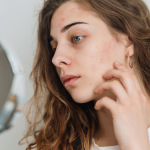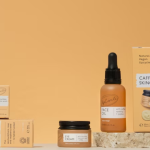Showering may seem simple—lather, rinse, repeat—but dermatologists approach it with a bit more intention. That’s because the skin is the body’s largest organ, and how it’s cleaned, exfoliated, and moisturized can make all the difference in long-term health, hydration, and glow. So what exactly does a dermatologist-approved bodycare routine look like? It’s not about dozens of products or expensive treatments—it’s about getting the basics right.
Here’s a step-by-step shower tips, straight from expert recommendations, that prioritizes skin barrier health, hydration, and gentle cleansing.
10 Expert Shower Tips for Glowing Skin, Backed by Derms
1. Keep Showers Short and Lukewarm
Long, steamy showers may feel like the ultimate self-care ritual, but for skin health, they’re often doing more harm than good. Hot water strips away the skin’s natural oils and weakens its moisture barrier, leaving it vulnerable to dryness, itching, and flare-ups—especially for those with conditions like eczema, psoriasis, or sensitive skin. Dermatology experts advise limiting showers to 5 to 10 minutes and using lukewarm water rather than hot. This helps prevent the skin’s natural oils from being stripped away, reducing the risk of dryness, irritation, and barrier damage—especially for those with sensitive or eczema-prone skin.
This gentle approach helps retain the skin’s hydration levels while still effectively cleansing the body. For those living in areas with hard water, which can contribute to dryness and irritation due to high mineral content, a shower filter or water softener can make a noticeable difference in skin feel and overall comfort. Less is more when it comes to water exposure—preserve hydration where it matters most.
2. Choose a Gentle, Fragrance-Free Cleanser
Soap doesn’t need to be harsh or overly foamy to be effective. In fact, most dermatologists advise avoiding cleansers with strong fragrances, sulfates, or alcohols, all of which can irritate and dry out the skin. Instead, opt for a pH-balanced, sulfate-free body wash formulated with barrier-supportive ingredients like ceramides, glycerin, or hyaluronic Acid. These help cleanse the skin while maintaining its protective layer and locking in moisture.
Application technique matters, too. Rather than using abrasive loofahs or sponges that can harbor bacteria and cause microtears, dermatologists recommend washing with clean hands or a soft washcloth. And not all body areas require the same level of cleansing. The face, underarms, groin, and feet may need targeted attention, while the rest of the body often benefits from a lighter touch. Always use products specifically designed for more delicate areas when needed.
3. Exfoliate Thoughtfully (1–2 Times a Week)
Exfoliation is key to smooth, radiant skin—but only when done properly. Exfoliation should gently clear away dead skin while preserving the skin’s barrier to maintain a smooth, healthy complexion.
Over-exfoliating—especially with rough physical scrubs—can lead to inflammation, tiny tears, and increased sensitivity. That’s why dermatologists typically favor chemical exfoliants over physical ones for the body.
Ingredients like lactic Acid, glycolic Acid, or salicylic acid work by gently dissolving the bonds between dead cells, revealing smoother, brighter skin underneath. These are especially beneficial for areas prone to rough patches or keratosis pilaris, such as the backs of arms, thighs, and upper back. For those who still prefer manual exfoliation, soft mitts or silicone scrubbers paired with gentle, circular motions provide a safer option. Limit exfoliation to once or twice per week, and always follow up with a nourishing moisturizer to reinforce the skin barrier.
4. Shave at the End of the Shower (If Applicable)
Timing matters when it comes to shaving, and dermatologists agree: the end of a warm shower is the optimal moment. At this stage, hair is softened and skin is more flexible, which helps minimize tugging, razor burn, and irritation during shaving. A sharp, clean razor is essential—not only for a smoother shave but also to prevent nicks and minimize bacterial buildup, which can lead to folliculitis or acne-like bumps.
Swap out drying bar soap for a hydrating shave gel or cream that cushions the skin and softens hair for a smoother shave. Shaving with the grain, particularly in sensitive spots, helps prevent ingrown hairs. After shaving, rinse with cool water to reduce irritation and pat the skin dry—avoid rubbing. Finish with a fragrance-free moisturizer to soothe and hydrate.
5. Moisturize Immediately After Drying Off
Hydration goes beyond water—it relies on effectively locking moisture into the skin. Dermatologists advise applying moisturizer within three minutes of finishing a shower, while skin is still damp. This quick step helps lock in moisture and supports a strong, healthy skin barrier.
Creams and ointments typically outperform lotions for dry, sensitive, or compromised skin due to their thicker, more hydrating formulas. Opting for fragrance-free products reduces the risk of skin irritation and allergic reactions. Key ingredients to look for on labels include:
- Ceramides – to restore the skin’s natural barrier and improve long-term hydration
- Urea or Lactic Acid – for mild exfoliation and hydration, especially for rough or bumpy areas
- Shea Butter – for nourishing moisture that penetrates deeply and soothes dryness
For those with very dry or eczema-prone skin, consider applying an occlusive layer (like petrolatum, Vaseline, or a balm) over problem areas after moisturizing. This added layer creates a barrier that locks in moisture and shields the skin from external irritants.
6. Use Sunscreen if Showering in the Morning
Showering in the Morning? Then SPF is non-negotiable. Even if the routine ends indoors, incidental sun exposure—during commutes, at the office window, or while running errands—adds up over time. Dermatologists emphasize that broad-spectrum sunscreen is one of the most effective tools for preventing premature aging, hyperpigmentation, and skin cancer.
Apply SPF 30 or higher to all exposed areas: neck, chest, arms, legs, hands, and anywhere the sun might reach. Don’t forget commonly missed spots like the tops of the ears, the back of the neck, and the tops of the feet if sandals are in the mix. For daily use, opt for a lightweight, non-comedogenic body sunscreen that absorbs quickly and won’t leave a greasy residue.
Sun protection goes beyond seasonal care—it’s a daily commitment to long-term skin health.
7. Consider Weekly Add-Ons: Body Serums and Targeted Treatments
Bodycare goes beyond basic moisture—especially for those dealing with textural issues, discoloration, or breakouts. Incorporating body serums and actives once or twice a week can help treat these concerns more effectively. Dermatologists often recommend specific ingredients depending on the issue:
- Niacinamide: A multitasking hero that brightens uneven tone, strengthens the skin barrier, and reduces inflammation. Ideal for dullness or discoloration.
- Salicylic Acid (BHA): Penetrates pores to dissolve oil and debris, making it especially effective for treating body acne and keratosis pilaris.
- Retinol: Encourages cell turnover, fades dark spots, and smooths texture. A favorite for addressing crepey skin, sun damage, and post-inflammatory marks—but best used at night and always paired with daily SPF.
Because active ingredients can cause irritation if used too frequently, start slow: once a week, then gradually build up depending on tolerance. Always follow with a barrier-repairing moisturizer to reduce the risk of flaking or sensitivity.
8. Finish with Sunscreen (Daytime Routine Only)
Sunscreen is the most crucial step in any morning bodycare routine. Though often linked to sunny outings, dermatologists emphasize its daily use—particularly on areas like the neck, arms, hands, chest, and legs that are regularly exposed to light.
Broad-spectrum SPF 30 or higher shields the skin from both UVA rays, which cause aging, and UVB rays, which lead to sunburn. Daily exposure—even through windows or under clouds—can accelerate fine lines, dark spots, and skin cancer risk. For a lightweight finish, look for non-greasy body sunscreens with added skincare benefits like niacinamide or vitamin E.
Sunscreen doesn’t just protect—it preserves all the progress made with exfoliants, serums, and moisturizers.
9. Upgrade Weekly with Treatments
Beyond daily maintenance, the skin benefits from targeted weekly treatments that address long-term concerns. Dermatologists suggest choosing formulas based on specific goals:
- For dullness: Vitamin C body serums deliver antioxidant protection while brightening skin tone.
- For uneven texture: Retinol body lotions improve roughness, soften lines, and promote a smoother appearance.
- For hyperpigmentation, Tranexamic Acid, kojic Acid, or niacinamide work to fade dark patches caused by acne, sun exposure, or hormonal shifts.
- For acne-prone areas: Sprays or lotions with salicylic Acid, tea tree oil, or azelaic acid help unclog pores and calm inflammation.
Introduce only one new active at a time, and limit treatments to once or twice per week to avoid overwhelming the skin. Apply these treatments to clean, dry skin, then follow with a moisturizer to strengthen the barrier and boost effectiveness.
10. Don’t Ignore the Microbiome
Emerging research highlights the role of the skin microbiome—a balanced ecosystem of microorganisms that protects against irritation, infection, and inflammation. When the microbiome is disrupted (by over-cleansing, harsh soaps, or antibacterial washes), the skin becomes more prone to dryness, sensitivity, and breakouts.
To support a healthy microbiome:
- Use gentle, non-stripping cleansers with minimal surfactants
- Avoid excessive scrubbing or antibacterial products unless prescribed
- Explore prebiotic and probiotic body care, such as lotions or washes designed to feed and balance good bacteria
- Supporting the skin’s microbiome isn’t just a trend—it’s a long-term investment in skin resilience and natural immunity.
The Science of a Smarter Shower
Showering like a dermatologist involves minimizing harsh factors while emphasizing skin-friendly practices. It focuses on preserving the skin barrier, using gentle products, and finishing with hydration and care. The outcome? Skin that’s not just clean, but genuinely nourished, balanced, and well-protected.
Because when bodycare meets science, even something as ordinary as a shower becomes a small act of skincare wisdom.


